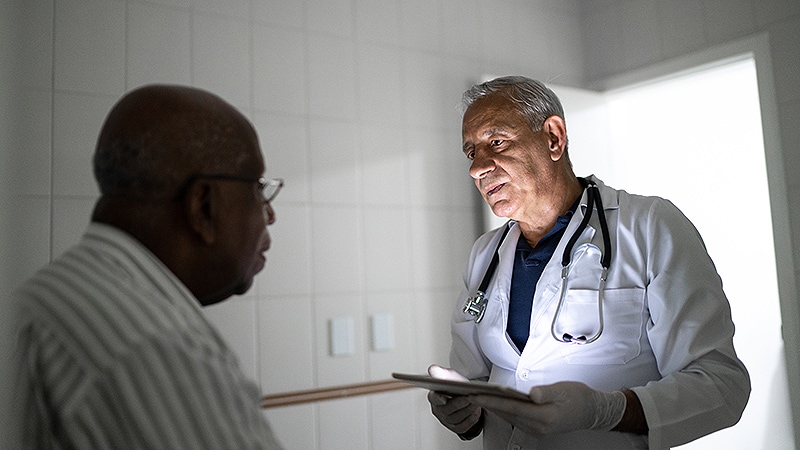DENVER — With continuous glucose monitors (CGMs) becoming vital tools for managing diabetes, the technology, soon to become available over the counter, is gaining popularity in off-label use to help people with obesity who may be on the verge of developing diabetes to reverse that path, while also helping diagnose some earlier, experts reported.
“Continuous glucose monitors can help guide and motivate patients to improve nutrition and activity [in patients with obesity], as well as change behavior,” said Lori Wenz, a nurse practitioner with Western Colorado Weight Care, of Grand Junction, Colorado, while presenting on the issue at Obesity Medicine (OMA) 2024.
“They can be great tools for sticking to nutrition and pharmacotherapy while increasing patients’ awareness of how their lifestyle affects their metabolic health,” she said.
Of the estimated 38% of adults in the United States with pre-diabetes, as many as 80% are unaware of their diagnosis, while 23% of the 11.6% of Americans with diabetes are also unaware that they have the disease, Wenz noted, citing data from the Centers for Disease Control and Prevention.
Importantly, as many as 90% of those with diabetes are overweight or have obesity.
While CGMs are currently approved by the US Food and Drug Administration (FDA) specifically for use in patients with diabetes, their off-label use in the management of patients with obesity is gaining favor as clinicians and patients alike become more aware of their diabetes risk proactive in monitoring their weight and health, Wenz told Medscape Medical News.
“Off-label use of CGM has increased significantly over the past 3-5 years,” she said. “The popularity is associated with the improvement in technology, allowing for lower cost and communication of the CGM with mobile devices.”
The main objectives for using CGM in patients without diabetes can vary, she added.
“With the high rates of diabetes unawareness and overweight and obesity, CGM can assist with diagnosing prediabetes or diabetes,” Wenz said.
“For those with prediabetes, CGM can support behavior changes that support improved glucose control to delay progression to diabetes or even reverse their disease,” she explained.
Of note, “CGM has demonstrated improved glucose control for those with diabetes without the addition of medications through the reinforcement of behavior change,” suggesting the potential for similar benefits in those with pre-diabetes or who are at risk, Wenz added.
In an increasingly metric-obsessed society, with tracking of everything from steps taken to the number of bites of food consumed in a day, CGMs offer even more innovation, with real-time readings of glucose fluctuations that most patients may not have previously even been aware of or comprehended — and may be motivated to better control.
“Our focus has shifted to one of prevention,” said Shagun Bindlish, MD, of One Medical, who also presented in the session.
Traditionally, patients with obesity may initially present with only mildly impaired fasting glucose on a blood test in an exam, only to return 6 months later and already have high levels.
“CGM at least gives them an idea of where they are and the chance to take action now, instead of months later after the next appointment,” she said.
Patients often use apps along with CGMs allowing them to enter the dietary details of their day, which can provide eye-opening revelations on the often-striking differences in how food choices can influence glucose fluctuations.
Over-the-Counter CGM Coming Soon
While there are various options for CGMs, all currently require a prescription, but in March, the FDA approved the first over-the-counter CGM, which may significantly shake things up, Wenz said.
The CGM, called the Dexcom Stelo Glucose Biosensor System, is approved for those older than 18 years who do not use insulin, “such as individuals with diabetes treating their condition with oral medications or those without diabetes who want to better understand how diet and exercise may impact blood sugar levels,” the FDA reported.
The FDA cautions that “importantly, this system is not for individuals with problematic hypoglycemia [low blood sugar], as the system is not designed to alert the user to this potentially dangerous condition.”
In the statement, Jeff Shuren, MD, JD, director of the FDA’s Center for Devices and Radiological Health, endorsed that “CGMs can be a powerful tool to help monitor blood glucose.”
“Today’s clearance expands access to these devices by allowing individuals to purchase a CGM without the involvement of a healthcare provider,” he said in the statement.
“Giving more individuals valuable information about their health, regardless of their access to a doctor or health insurance, is an important step forward in advancing health equity for US patients.”
The Stelo system uses a wearable sensor that is paired with an application installed on the user’s smartphone or other device, continuously measuring, recording, analyzing, and displaying glucose values.
The device will come with an auto-injector device that patients use themselves; once the catheter is inserted in the skin, a transmitter adheres to the skin surface with adhesive, Wenz explained.
The system, which provides blood glucose measurements and trends every 15 minutes in the accompanying app is designed to be worn up to 15 days before requiring replacement.
The FDA recommends that “users should not make medical decisions based on the device’s output without talking to their healthcare provider”; however, the device will not require partnering with a clinician to analyze the results.
Of note, the FDA had issued a warning months earlier regarding the use of unauthorized glucose monitors, due to various concerns, including the potential for inaccurate blood glucose measurements.
Caveats
Among key caveats of CGM use in obesity before developing diabetes is that there are currently no standards for ideal glucose levels in patients without diabetes, and some readings can be difficult to interpret, Wenz explained.
“The more data that is gathered in this population, the more we are coming to understand that blood glucose in people without diabetes can be normal in the 50s and 60s — a range that is traditionally thought to be concerning or even dangerous in patients with diabetes,” she said.
Furthermore, CGMs meant for people with diabetes are designed to alarm and notify the wearer when glucose levels are below 70, Wenz added. “These alarms can become a hassle for the wearer — like when they wake you from sleep.”
There is also debate over the rate of change in glucose levels as well as glucose variability among patients without diabetes, she added.
“Based on the data from patients with diabetes, we know that both factors can contribute to cardiovascular disease if not controlled.”
Other concerns include that visualizing changes in glucose could result in anxiety and stress.
“There is some concern that people will use CGM to control their glucose to the extreme, keeping tight control without any variability to the extent that they develop unhealthy eating patterns or disordered eating or at least without any health improvement,” Wenz noted.
Game-Changer?
Nevertheless, with proper use, over-the-counter CGMs (more are expected to follow) could be game-changers in helping people with obesity take control of their health destiny.
“I do suspect these devices will have the potential to improve metabolic health and prevent disease progression for people with prediabetes, impaired fasting glucose,” Wenz said.
Importantly, the prices of over-the-counter CGMs are expected to drop below the prescription-based devices, meaning that “people using the subscription CGM services may choose to buy the OTC version as a cost saving alternative,” Wenz added.
Alaina Vidmar, MD, an assistant professor of clinical pediatrics at the Keck School of Medicine of University of Southern California and director of Obesity Medicine and Bariatric Surgery at Children’s Hospital Los Angeles, who has published research on the use of CGM in Obesity Research & Clinical Practice, noted that her experience with CGMs shows benefits also in children in weight loss interventions.
“In my current research studies on time-restricted eating on youth with obesity, with or without diabetes, we have all participants wear CGMs, and what we find is that having access to real-time data educated them about their bodies and its response to certain foods, reminds them of their participation in our program and what the aim of the trial is, encourages them to continue to adhere to the programs tenets,” Vidmar told Medscape Medical News.
Noting that an ongoing issue is getting insurance coverage for CGM use in patients without diabetes, she underscored the potential benefits: “We need all the tools we can, which include concurrent use of thoughtful, innovative health and behavioral modification approaches, pharmacotherapy, and surgery to help youth with obesity live long health lives.”
“This work is not about the number on the scale or the size of one’s body but preventing life-limiting complications over time, which can allow these children and adolescents to thrive,” she said.
“Thus, a real-time monitor like a CGM may allow for more advance diagnosis of pre-diabetes and diabetes and, thus, more thoughtful approaches to prevention and treatment.”
Vidmar noted that as over-the-counter CGM products enter the market, “the hope is that we have multiple products to work with that are sensitive and specific to monitoring glucose profiles across ages and weight categories to allow access to this technology for all.”
Wenz is on speakers’ bureaus for Eli Lilly and Obesity. Bindlish is on the non-commercial medical advisory board for Novo Nordisk. Vidmar has participated in an advisory board for Rhythm Pharmaceuticals.










